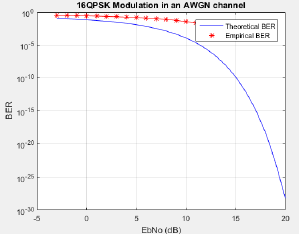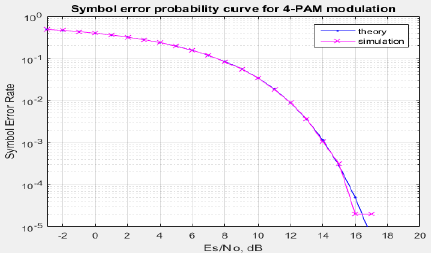Gaming Industry. Game engines are written in C++. Web Browsers. Eg: Chromium Browser,Firefox,Google Chrome use C++. Operating Systems. Eg: Apple's OS X,Microsoft,Symbian OS use C++. Graphics. Eg: Adobe Photoshop,Illustrator,Acrobat are all developed using C++. Systems Programming. Embedded Systems. Multimedia Players. VLC,Windows Media Player. This link provides a list of systems,applications and libraries written in C++.... Continue Reading →
Why C++ ?
Bjarne Stroustrup designed the C++ language in 1979. It is a general-purpose language for systems programming. Let us look at some features of C++ language. C ++ is a portable language - It can be used for multiple platforms or operating systems. C++ supports Object Oriented Programming - Object Oriented Programming involves the concept of Class and Object.... Continue Reading →
32QAM MODULATION(BER vs SNR)
Program: clc; clear all; close all; M=64; k=log2(M); n=10^5; x = randi([0 1],n,4); Z = bi2de(x); y = qammod(Z,M,0,'gray'); scatterplot(y); N=length(y); SNR=-3:20; for i=1:length(SNR) noise2=awgn(y,SNR(i)); Y2=qamdemod(noise2,M,0,'gray'); ser2=step(comm.ErrorRate,Z,Y2); serVec2(i)=ser2(1); end semilogy(SNR,serVec2); axis([-3 20 10^-5 1]) grid on xlabel('Eb/No (dB)'); ylabel('BER'); title('32QAM Modulation in an AWGN channel'); RESULT:
Calendar in Python
The module called calendar allows you to output calendars and provides additional useful functions related to the calendar. By default, these calendars have Monday as the first day of the week, and Sunday as the last (the European convention). The 4 parameters are 2018,2,1,6. 2018 is the year , 2 is the width in character of... Continue Reading →
More File Operations using Python
To check if a file exists . The above code checks if there is a file called p.py in the current directory and prints True or False. Initially the code checks for a file called k.py which is not present .So it prints False. Then in the 2 nd code, it checks for a file... Continue Reading →
What is the date and time ?
Let us learn to print the current date and time using Python. We will be using the datetime module for this purpose. First we import date from datetime module. According to the python documentation, the datetime module supplies classes for manipulating dates and times in both simple and complex ways. We assign today's date to the... Continue Reading →
16QAM MODULATION (BER vs SNR)
MATLAB CODE: clc; clear all; close all; M=16; %for 16 QAM k=log2(M); %defining no. of bits n=10^5; %taking 100000 no. of bits x = randi([0 1],n,4); %generation of random binary bits Z = bi2de(x); %binary to decimal conversion y = qammod(Z,M,0,'gray'); % QAM modulation scatterplot(y); N=length(y); SNR=-3:20; for i=1:length(SNR) noise2=awgn(y,SNR(i)); %defining AWGN noise and adding... Continue Reading →
32-QPSK MODULATION(BER vs SNR)
MATLAB CODE: clc; clear all; close all; M =32; %channel modulation and de-modulation----------------------------------------------------------------------- hMod = modem.pskmod(M); hDemod = modem.pskdemod(hMod); % Generate data stream--------------------------------------------------------------------------------------------------- tx = randint(10000,1,M); % Modulate the data--------------------------------------------------------------------------------------------------------- txSig = modulate(hMod, tx); % Compute error rate for different values of SNR------------------------------------------------------------- EbNo = (-3:20); k = log2(M); SNR = EbNo+10*log10(k); % Range of... Continue Reading →
16PSK MODULATION(BER vs SNR)
MATLAB CODE: clc; clear all; close all; M = 16; %channel modulation and demodulation------------------------------------------------------------------------ hMod = modem.pskmod(M); hDemod = modem.pskdemod(hMod); % Generate data stream--------------------------------------------------------------------------------------------------- tx = randint(10000,1,M); % Modulate the data-------------------------------------------------------------------------------------------------------- txSig = modulate(hMod, tx); % Compute error rate for different values of SNR------------------------------------------------------------ EbNo = (-3:20); %defining SNR range (in dB) k = log2(M);... Continue Reading →
PAM (SER vs SNR)
MATLAB CODE: clc; clear all; close all; N = 10^5; % number of symbols %modulation with noise------------------------------------------------------------------------------------- pam4 = [-3 -1 1 3]; % order of PAM. Here, its 4th order or 4-PAM alphabets Es_N0_dB = [-3:20]; % multiple Eb/N0 values ip = randsrc(1,N,pam4); for v = 1:length(Es_N0_dB) s = (1/sqrt(5))*ip; % normalization of... Continue Reading →








